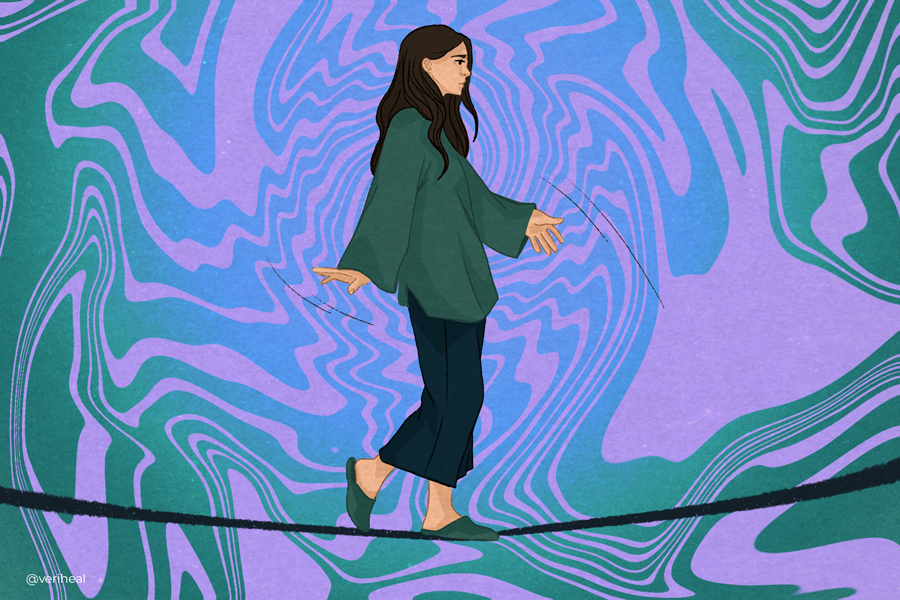Friedreich’s Ataxia

- Friedreich’s Ataxia: Signs, Symptoms and Types
- Friedreich’s Ataxia Treatment: Can Cannabinoids Provide Relief?
- The Role of the Endocannabinoid System in Treating Friedreich’s Ataxia
- What Preparations of Cannabis are Best for Friedreich’s Ataxia?
- Talk to Your Doctor About Medical Cannabis
Friedreich’s ataxia, abbreviated as FRDA or FA, is an autosomal-recessive genetic disease that impairs walking ability and causes gradually-worsening speech loss and lack of sensation in the limbs. The progressive condition is inherited by receiving two copies of a specific genetic mutation.
The symptoms of Friedreich’s ataxia tend to transpire between the ages of 10-15. According to the NIH (National Institutes of Health), this neurodegenerative movement disorder impacts one in every 50,000 people (10).
Approximately ten percent of people with FRDA will also develop diabetes mellitus. Heart disease is common in up to one-third of cases, which is why it’s so essential to medicate with a doctor-approved type of medicine.
People with Freidrich’s Ataxia may suffer from poor quality of life. While there is no known cure for Friedreich’s ataxia, doctors will usually prescribe a wide variety of treatments such as medications, referrals to cardiologists, speech therapy, physical therapy, and sometimes cannabis to help patients cope with the symptoms.
Friedreich’s Ataxia: Signs, Symptoms and Types
The rate at which FA develops depends on each case. Within 10-20 years of first receiving a diagnosis, patients will usually require wheelchair transport. During the later stages of the disease, individuals may struggle to perform typical day-to-day duties like walking up or down the stairs and cooking food.
Initially, symptoms that tend to surface in Friedreich’s ataxia patients include balance and posture problems, muscle spasticity, and the inability to conduct voluntary movements (ataxia) like walking, which may result in frequent falling. The affected individual might also have slurred speech (dysarthria), irregular spinal curvature (scoliosis), or foot deformities.
When visiting a doctor for an official diagnosis, they will likely perform a physical exam and try to differentiate among the six main types of ataxia: acquired ataxia, hereditary ataxia, idiopathic late-onset cerebellar ataxia (ILOCA), proprioceptive ataxia, cerebellar ataxia and vestibular ataxia. They will also take a medical history and may require a referral from a specialist and further testing. Genetic testing will yield a conclusive diagnosis.
Friedreich’s Ataxia Causes and Complications
Life is usually cut short for FA patients, with the typical life expectancy being between 30 and 60 years old. One of the primary culprits of early death in FA patients is heart disease, which is usually structural.
Damage to the spinal and peripheral nerves is the leading cause of Friedreich’s ataxia, including cerebellum degeneration.
A large bundle of nerves makes up the spinal cord, which is connected to the brain and body through a network of peripheral (outside the spinal cord) nerves. These nerves transmit essential impulses to your brain, body, and vice-versa that instruct the body to move, feel your body position in space, judge movements, and experience sensations.
The cerebellum, on the other hand, can be found at the base of the brain. It is responsible for influencing the following processes:
- Balance while sitting, standing, and walking
- Speech
- Eye movements
- Limb coordination
- Impaired sensory functions
Research suggests that the abnormal copies of the frataxin gene cause oxidative cell levels to build up, thus destroying them over time. Early identification is key to helping battle gradually-worsening symptoms and co-occurring diagnoses for several years.
One of the worst-case scenarios would be receiving a hypertrophic cardiomyopathy diagnosis. This serious structural heart disease is common in FA patients who seek treatment too late. Statistics show that approximately 75% of people with FA have this heart-weakening and enlarging illness (9).
Friedreich’s Ataxia Treatment: Can Cannabinoids Provide Relief?
Ataxia is an umbrella term used to describe a group of medical conditions that cause adverse side effects on the cerebellum region of the brain. The cerebellum is a part of the brain that maintains balance, speech, eye movement, and limb coordination. Aside from the brain, ataxia can also impact other essential nervous system functions, such as the peripheral nerves and spinal cord.
Cannabis compounds, A.K.A ‘cannabinoids’ are naturally produced by the Cannabis sativa plant species. Each cannabinoid has unique effects on the human body, many of which play an essential role in FRDA cases. Although the evidence supporting the use of cannabis and its non-psychoactive compound CBD (cannabidiol) is somewhat limited, certain patients may experience symptomatic relief using such products. This thinking could be based on how 1:1 CBD: THC has shown modest efficacy on spasticity in multiple sclerosis (MS), for example (7). Yet, there is no published research on Freidrich’s ataxia and cannabis.
Information written in a thesis submitted to Brunel University Research Archive (BURA) has highlighted the power of antioxidant therapy with cannabinoids CBD and THC related to Friedrich’s ataxia (6). This thesis is one of the only, if not sole, research papers on cannabis and Friedrich’s ataxia. It theorizes how cannabis’ antioxidant properties could help to maintain better overall health and improve cell damage. Unfortunately, the research project did not find any significant antioxidant or other benefits in lab trials with mice.
Based on research published in Human Molecular Genetics, “a long-standing hypothesis is that FRDA is due to an iron-mediated oxidative stress.” This is worth mentioning since research indicates that levels of oxidative stress can be reduced with cannabis consumption (2).
The Role of the Endocannabinoid System in Treating Friedreich’s Ataxia
Friedreich’s ataxia is closely connected with many body systems, including the endocannabinoid system (ECS). The ECS produces and uses cannabinoids to regulate our functions, such as thinking, mood, memory, hunger, pain, and sleep. As a disease that occurs due to decreased mitochondrial frataxin — a mitochondrial protein involved in iron homeostasis — the ECS’ role in maintaining homeostasis significantly affects FRDA patients (2). This increased oxidative stress causes nerve damage over time and, thus, the progressive symptoms of FRDA.
The therapeutic advantages associated with a properly-functioning ECS happen when a cannabinoid directly or indirectly stimulates the system’s CB1 and CB2 cannabinoid receptors, that bind with the cannabinoids produced by the body (endocannabinoids) or cannabis-derived compounds like CBD or THC (phytocannabinoids). This is primarily how THC works.
CBD instead acts on ECS enzymes to boost endocannabinoid tone and works on TRPV1, dopamine, and serotonin receptors that may also play a role in oxidative stress, pain, and movement disorders (8).
Friedreich’s ataxia causes the peripheral nerves and spinal cord nerve fibers to degrade and become thinner. The cerebellum, a portion of the brain located behind the brainstem responsible for maintaining physical movement and coordination via sensor detection, also degenerates somewhat.
This damage results in impairment to your sensory functions and prompts a wide range of impaired physical movements. Fortunately, an evolving sphere of medical cannabis research paints an ever-clearer picture of the plant’s ability to interact with the brain and release a vast array of antioxidant, anti-inflammatory, and neuroprotective effects, as reported in this study, among many others, suggesting that the plant and its compounds might help maintain optimum brain and nerve health (4).
Considering the critical role of the peripheral nerves, which transfer information to your body and then direct it back to your brain, cannabis’ neuroprotective capabilities should not be ignored in this area of medicine. One prime example of how the peripheral nerves can influence your mobility is by sending signals to specific muscles that power the legs or arms. There is also limited evidence regarding cannabinoids and movement disorders like MS (8).
What Preparations of Cannabis are Best for Friedreich’s Ataxia?
Technological advancement has pushed the realm of medical cannabis in totally new directions. Patients can now choose from various preparations for consuming the herb. Sublingual, topical, oral, inhalation, and rectal administration are the main consumption methods available to people with FA. Each method has distinct advantages and possible drawbacks.
Listed below are examples of cannabis preparations that fall into the above categories:
- Edibles and Beverages — Whether it’s an oil-infused apple pie, a cannabinoid-enriched gummy, or a beverage that contains water-soluble cannabinoids, you can expect the effects to remain for 5-8 hours. Start low and go slow with this potent preparation
- Transdermal Patches — Transdermal patches make it possible for cannabinoids to enter the bloodstream after penetrating layers of skin. A suitable option if you’re seeking out a type of cannabis preparation for extended release, patches are ideal for private use on the move.
- Vapes and Joints — Vaping and smoking cannabis heats the oil, resin, concentrates, or raw flower (depending on the type of medical cannabis you opt for when treating the symptoms of FA) to a temperature that spurs on the release of cannabinoids and other therapeutic compounds. The effects usually materialize within 30 seconds to a few minutes.
- Tinctures — Many FA patients prefer tinctures made by soaking cannabis flower in a strong solvent, such as alcohol. This process results in concentrated cannabis extract. One of the main appeals of tinctures is that they are convenient, highly discreet, and allow for controlled dosing; each drop delivers a specific ‘mg’ of cannabinoids.
- Pills, Capsules, and Tablets — Cannabis can be consumed just like any other medication that comes in the form of a pill, capsule or tablet. This might be a good choice if you lead a busy lifestyle and want to feel reassured that you’re consuming a consistent and easily-dosed medicine for FA.
Talk to Your Doctor About Medical Cannabis
Targeting the root cause of the problem and relieving yourself of the physical, mental, and emotional burden that comes with an FA diagnosis is possible when you visit a qualified doctor. They should be well-versed on cannabis, so make sure you entrust a reputable company like Veriheal to connect you with recommended medical marijuana doctors.
After you have received a diagnosis for Friedreich’s ataxia, you can start considering the medical benefits of cannabis-based treatment options with your doctor. However, you should avoid using cannabis instead of other doctor-advised medications and physical or speech therapy.
It’s also imperative that you pay close attention to the type of medication(s) you currently use since they may trigger a chemical reaction that increases or decreases the effects of cannabis and concurrent medications (interactions).
Complementary Treatments Worth Discussing with Your Doctor
Whatever methods of treatment you choose to use for coping with the symptoms of Friedreich’s ataxia, it’s often advisable to try complementary medicine, too. Complementary medicine is not deemed to be a standard treatment option, but it can be used alongside the medication your doctor prescribes you.
One such example of a complementary medicine worth trying if you suffer from FRDA is antioxidant therapy. This treatment has been proven to enhance in vivo cardiac and skeletal muscle bioenergetics in patients with the disease, as per the study’s findings published on PubMed (3).
The research focused on six months of antioxidant treatment (Coenzyme Q10 400 mg/day, vitamin E 2,100 IU/day) on cardiac and calf muscle energy metabolism in 10 patients with FA. Overall, improvements were sustained for six months after antioxidant therapy.
Other complementary medicine examples include massage, meditation, tai chi, reiki, music therapy, visualization techniques, and dietary supplements. Combined with medical cannabis use—a safer alternative to opioid painkillers as demonstrated in clinical trials — the recovery process for FA patients could be shortened and muscle spasms relieved.
By integrating the medical use of marijuana into your healthcare routine, maintaining a high quality of life after being diagnosed with a neurodegenerative disorder is possible.
Cannabis strains or chemovars rich in terpenes and containing therapeutically-abundant cannabinoids like delta-9 tetrahydrocannabinol (THC) may exert analgesic effects on FA patients. Strains high in cannabidiol (CBD) exert antioxidative, anti-inflammatory, and relaxing effects on FA patients (1, 5).
Note: The content on this page is for informational purposes only and is not intended to be professional medical advice. Do not attempt to self-diagnose or prescribe treatment based on the information provided. Always consult a physician before deciding on the treatment of a medical condition.
- Atalay, S., Jarocka-Karpowicz, I., & Skrzydlewska, E. (2019). Antioxidative and anti-inflammatory properties of Cannabidiol. Antioxidants, 9(1), 21. https://www.ncbi.nlm.nih.gov/pmc/articles/PMC7023045/#:~:text=Therefore%2C%20it%20has%20been%20suggested,of%20immune%20cells%20%5B66%5D
- Kopustinskiene, D. M., Masteikova, R., Lazauskas, R., & Bernatoniene, J. (2022). Cannabis sativa L. bioactive compounds and their protective role in oxidative stress and inflammation. Antioxidants, 11(4), 660. https://www.mdpi.com/2076-3921/11/4/660/htm
- Lodi, R., Hart, P. E., Rajagopalan, B., Taylor, D. J., Crilley, J. G., Bradley, J. L., Blamire, A. M., Manners, D., Styles, P., Schapira, A. H., & Cooper, J. M. (2001). Antioxidant treatment improves in vivo cardiac and skeletal muscle bioenergetics in patients with Friedreich’s ataxia. Annals of neurology, 49(5), 590–596. https://pubmed.ncbi.nlm.nih.gov/11357949/
- Maroon, J., & Bost, J. (2018). Review of the neurological benefits of phytocannabinoids. Surgical Neurology International, 9(1), 91. https://www.ncbi.nlm.nih.gov/pmc/articles/PMC5938896/
- Mlost, J., Bryk, M., & Starowicz, K. (2020). Cannabidiol for pain treatment: Focus on pharmacology and mechanism of action. International Journal of Molecular Sciences, 21(22), 8870. https://www.ncbi.nlm.nih.gov/pmc/articles/PMC7700528/
- Mouro Pinto, R. (1970, January 1). Therapeutic testing and epigenetic characterization of Friedreich ataxia. Brunel University Research Archive: Home. Retrieved October 5, 2022, from https://bura.brunel.ac.uk/handle/2438/6335
- Nielsen, S., Murnion, B., Campbell, G., Young, H., & Hall, W. (2019). Cannabinoids for the treatment of spasticity. Developmental Medicine & Child Neurology, 61(6), 631–638. https://onlinelibrary.wiley.com/doi/full/10.1111/dmcn.14165
- Peres, F. F., Lima, A. C., Hallak, J. E., Crippa, J. A., Silva, R. H., & Abílio, V. C. (2018). Cannabidiol as a promising strategy to treat and prevent movement disorders? Frontiers in Pharmacology, 9. https://www.ncbi.nlm.nih.gov/pmc/articles/PMC5958190/
- Signs and symptoms of Friedreich’s ataxia (FA) – diseases. Muscular Dystrophy Association. (2021, April 28). Retrieved October 5, 2022, from https://www.mda.org/disease/friedreichs-ataxia/signs-and-symptoms
- U.S. Department of Health and Human Services. (n.d.). Friedreich ataxia fact sheet. National Institute of Neurological Disorders and Stroke. Retrieved October 5, 2022, from https://www.ninds.nih.gov/friedreich-ataxia-fact-sheet







